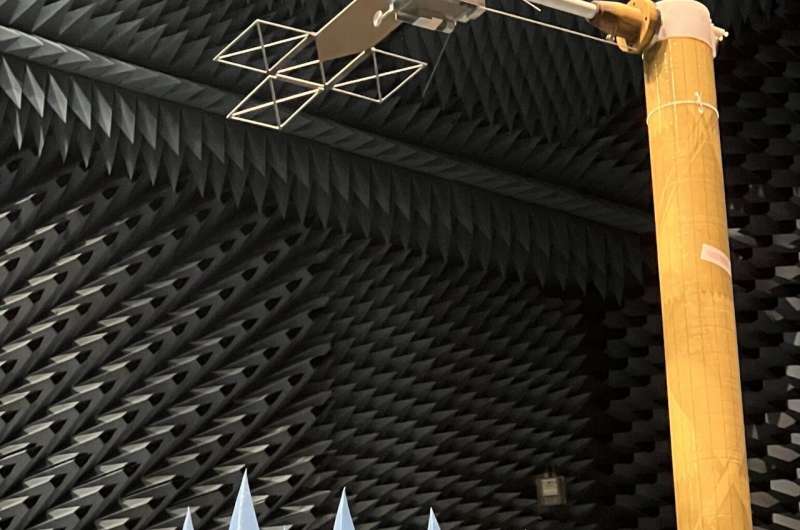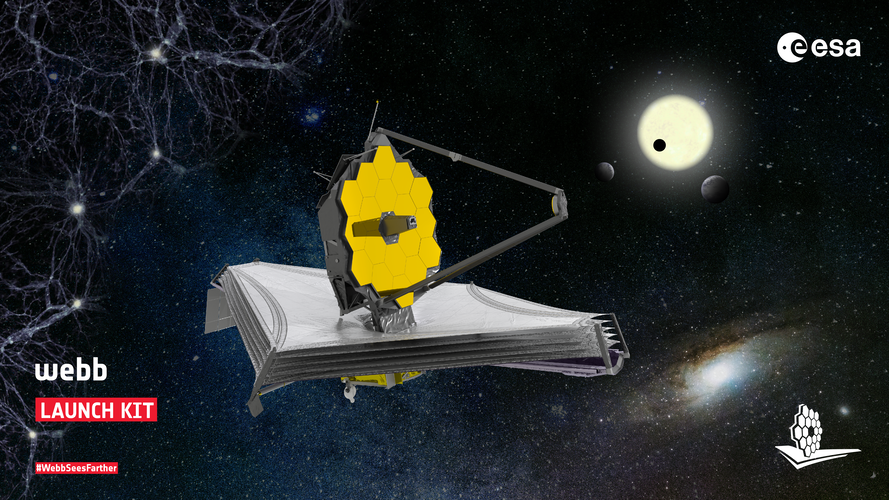
Copernical Team
Testing radar to peer into Jupiter's moons

A 1:18 scale model of Juice, ESA's spacecraft to explore the Jupiter system, is being employed to test its radar antenna.
The working version of the RIME instrument (Radar for Icy Moons Exploration), incorporating a 16-m long version of the straight 'dipole' boom seen here under the model spacecraft, will probe up to 9 km deep under the surfaces of the gas giant's main "Galilean' moons.
The testing took place in ESA's Hertz (Hybrid European RF and Antenna Test Zone) chamber based at ESA's ESTEC technical heart in the Netherlands.
Metal walls screen outside radio signals, while spiky foam interior cladding absorbs radio signals internally to create conditions simulating the infinite void of space.
This chamber's hybrid nature makes it unique: Hertz can assess radio signals from antennas either on a local 'near-field' basis or as if the signal has crossed thousands of kilometers of space, allowing it to serve all kinds of satellites and antenna systems.
A scaled model of the #JUICE Radar antenna is under characterization test @TestCentre.
Link to Webb launch kit

Webb launch kit
Interactive infographics and background information to prepare for Webb's launch
DARPA Announces Forecasting Floats in Turbulence Challenge Winners
 The mystery of knowing where the proverbial message in a bottle thrown overboard in the open sea will eventually wash ashore has not been solved. But DARPA's recent Forecasting Floats in Turbulence (FFT) challenge took an exploratory first step toward trying to understand the turbulent convergence of wind, waves, and currents on the surface of the ocean - and its effect on objects floating at se
The mystery of knowing where the proverbial message in a bottle thrown overboard in the open sea will eventually wash ashore has not been solved. But DARPA's recent Forecasting Floats in Turbulence (FFT) challenge took an exploratory first step toward trying to understand the turbulent convergence of wind, waves, and currents on the surface of the ocean - and its effect on objects floating at se L3Harris Completes Delivery of Imagers for NOAA's Advanced Environmental Satellites
 L3Harris Technologies has delivered its fourth imager to NASA, completing the series of advanced weather sensors for NOAA's newest Geostationary Operational Environmental Satellites (GOES) and lays the groundwork for future imager programs.
The fourth Advanced Baseline Imager (ABI) will be integrated into the GOES-U satellite, slated to launch in 2024, and will be operated by NOAA.
T
L3Harris Technologies has delivered its fourth imager to NASA, completing the series of advanced weather sensors for NOAA's newest Geostationary Operational Environmental Satellites (GOES) and lays the groundwork for future imager programs.
The fourth Advanced Baseline Imager (ABI) will be integrated into the GOES-U satellite, slated to launch in 2024, and will be operated by NOAA.
T Deadliest period in Earth's history was also the stinkiest
 Tiny microbes belching toxic gas helped cause - and prolong - the biggest mass extinction in Earth's history, a new study suggests. Generally, scientists believe Siberian volcanos spitting greenhouse gases primarily drove the mass extinction event about 250 million years ago, at the end of the Permian period. The gases caused extreme warming, which in turn led 80% of all marine species, as well
Tiny microbes belching toxic gas helped cause - and prolong - the biggest mass extinction in Earth's history, a new study suggests. Generally, scientists believe Siberian volcanos spitting greenhouse gases primarily drove the mass extinction event about 250 million years ago, at the end of the Permian period. The gases caused extreme warming, which in turn led 80% of all marine species, as well On they march as China records 401st flight of Long March rocket family
 China launched a relay satellite from the Xichang Satellite Launch Center in southwestern China early on Tuesday morning, according to China Aerospace Science and Technology Corp, the nation's major space contractor.
A Long March 3B carrier rocket blasted off at 0:09 am and then deployed the Tianlian II-02 satellite into orbit, the State-owned company said in a statement. The mission marke
China launched a relay satellite from the Xichang Satellite Launch Center in southwestern China early on Tuesday morning, according to China Aerospace Science and Technology Corp, the nation's major space contractor.
A Long March 3B carrier rocket blasted off at 0:09 am and then deployed the Tianlian II-02 satellite into orbit, the State-owned company said in a statement. The mission marke Kepler Communications announces testing of Aether Network with Spire Global
 Kepler Communications has signed a contract with Spire Global to launch a test of Kepler's Aether network. This will serve as an initial test bed for Kepler's Aether service and will also help Spire evaluate how the technology can support its goal to collect accurate, timely and global data.
Announced at Satellite 2021, Aether is the fulfilment of Kepler's mission to enable the space econo
Kepler Communications has signed a contract with Spire Global to launch a test of Kepler's Aether network. This will serve as an initial test bed for Kepler's Aether service and will also help Spire evaluate how the technology can support its goal to collect accurate, timely and global data.
Announced at Satellite 2021, Aether is the fulfilment of Kepler's mission to enable the space econo Northrop and Raytheon complete Next Generation Interceptor review
 The Northrop Grumman and Raytheon Technologies Next Generation Interceptor (NGI) team has completed its System Requirements Review (SRR) and is proceeding with initial system design, further risk reduction testing, and critical component qualification activities.
The Missile Defense Agency (MDA) approved the SRR, which was completed ahead of schedule, and is the first major technical revie
The Northrop Grumman and Raytheon Technologies Next Generation Interceptor (NGI) team has completed its System Requirements Review (SRR) and is proceeding with initial system design, further risk reduction testing, and critical component qualification activities.
The Missile Defense Agency (MDA) approved the SRR, which was completed ahead of schedule, and is the first major technical revie USSF's EPS-R Program on Schedule for Historic Polar Mission
 A unique partnership with Norway and the U.S. Space Force's Space Systems Command will extend satellite communications for U.S. polar forces and save taxpayers millions of dollars.
SSC's Enhanced Polar Systems-Recapitalization (EPS-R) program successfully completed the ready-to-ship review at the end of September for the first of two payloads to begin the integration process onto Space Nor
A unique partnership with Norway and the U.S. Space Force's Space Systems Command will extend satellite communications for U.S. polar forces and save taxpayers millions of dollars.
SSC's Enhanced Polar Systems-Recapitalization (EPS-R) program successfully completed the ready-to-ship review at the end of September for the first of two payloads to begin the integration process onto Space Nor Honeywell, SES and Hughes demonstrate Multinetwork Airborne Connectivity
 Honeywell, SES and Hughes have successfully demonstrated multinetwork, multiorbit high-speed airborne connectivity for military customers, a technological breakthrough that will enable government and military personnel to communicate between the ground and air more efficiently and securely than ever. Honeywell's JetWave MCX broadband satellite communication (SATCOM) solution, using an HM-series
Honeywell, SES and Hughes have successfully demonstrated multinetwork, multiorbit high-speed airborne connectivity for military customers, a technological breakthrough that will enable government and military personnel to communicate between the ground and air more efficiently and securely than ever. Honeywell's JetWave MCX broadband satellite communication (SATCOM) solution, using an HM-series 